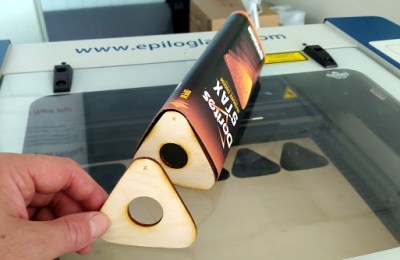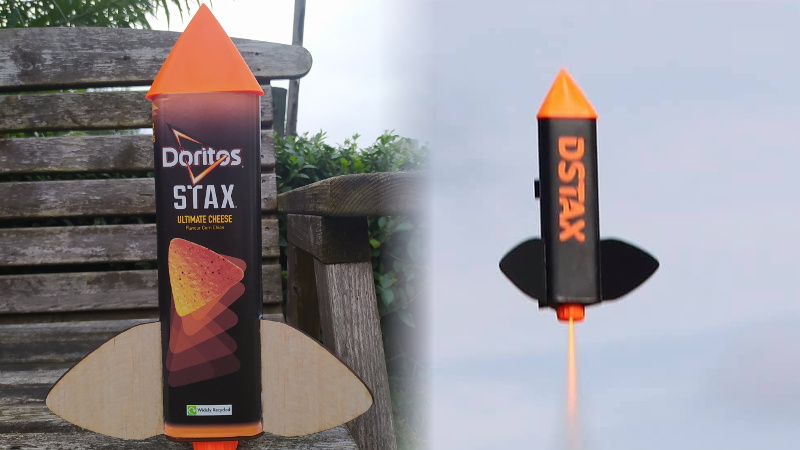Rocketry is tricky stuff, but as long as you’re not trying to get into space, the whole idea can basically be boiled down into a simple concept: if you put enough thrust behind it, anything can fly. At least, for awhile. It’s this basic premise that allows what hobbyists sometimes refer to as “Odd-Rocs” fly; these unusual objects might not be ideal rockets, but put a big enough motor in there, and it’ll get off the pad.
Recently, [concretedog] thought he’d try putting together his own oddball rocket, and set out to modify a Doritos STAX tube for powered flight. There’s plenty of precedent for turning Pringles tubes into rockets, but of course, that’s hardly surprising. After all, what’s a rocket if not a strong and lightweight cylinder? But the rounded triangular shape of the STAX tube promised to be an interesting change of pace. Plus it looked cool, so there’s that.
 Turning the snack container into a rocket was actually pretty straightforward. To start with, [concretedog] sketched around the outside of the tube on a piece of paper, and then took a picture of that with his phone. That image was then brought into Inkscape, and turned into a vector file that he could fiddle around with in CAD.
Turning the snack container into a rocket was actually pretty straightforward. To start with, [concretedog] sketched around the outside of the tube on a piece of paper, and then took a picture of that with his phone. That image was then brought into Inkscape, and turned into a vector file that he could fiddle around with in CAD.
Between the thin plywood cut on his laser and PETG loaded into his 3D printer, he was able to come up with a strong enough motor mount to take an Estes D12-5. He then created some fins to glue on the side, and a triangular nosecone. A simple recovery system was installed, and the whole thing was finished off with a Doritos-appropriate orange and black color scheme.
The unusual shape of the rocket meant simulating its flight characteristics on the computer wouldn’t work without custom software, so [concretedog] had to use the old school method of checking stability by swinging it around in a circle on a string. After trimming it out so it would orient itself properly on the tether, he was fairly sure it would fly straight under power. Sure enough, the video below shows the nacho cheese flavored rocket streaking skyward with impressive speed and stability.
It’s far from the most advanced model rocket we’ve seen recently, but we really appreciate the simplicity of this build. It’s a great reminder that fun doesn’t have to be high-tech, and that by following some basic construction principles, you can knock out a safe park flier rocket on a weekend.
















Doesn’t it have a dorito inside? After you recover it you could reach inside and get a dorito and eat it, now that would be cool!
Dorito from space! Just like the guy who ate a burger that was flown with a weather balloon into near space.
To boldly go where no corn chip has gone before!
Great job
@Tom Nardi said: “The unusual shape of the rocket meant simulating its flight characteristics on the computer wouldn’t work without custom software, so [concretedog] had to use the old school method of checking stability by swinging it around in a circle on a string.”
Surely simulating the Staxship is possible in KSP – right?
Can the replicators on the Cerritos produce Doritos?
You tell me?
https://youtu.be/ulx47lXMOO4?t=144
At first I thought it was going to be a hybrid rocket using the Doritos as fuel.
Doritos definitely burn, so if you ground them up and put them into a form with some kind of binder to hold it all together…huh. Even if it doesn’t develop enough thrust to fly, I’d like to see a Dorito engine burning on the stand.
Gummy bears in liquid oxygen might make for a higher specific impulse. Although I agree, it would be interesting to see how these hyperbolic paraboloid wafers of starch and sugar perform under test.
It would make a great body for a 3 paralell motor setup too, but those darn things never ignite simultanious Grr…
The swiss are taking up the challenge with their Toblerone space program